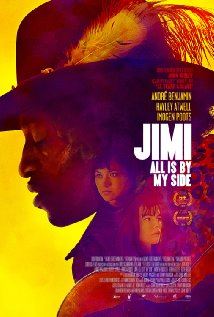Jimi: All Is by My Side movie review
By Beth Davies-Stofka
October 16, 2014 - 10:58
Writer(s): John Ridley
Starring: Andre Benjamin, Hayley Atwell, Imogen Poots
Directed by: John Ridley
Produced by: Ted Hamm, John Ridley
Running Time: 118 mins.
Release Date: 10 October 2014 (USA)
Rating: R (Restricted)
Distributors: Open Road Films (II) (USA)
Genre: Biography-Drama-Music
 |
In a London thrift shop, Kathy Etchingham is enchanted by a tiny music box. Nearby, her boyfriend Jimi Hendrix is trying on jackets. To Kathy’s consternation, the music box stops working. She says to the shop clerk, “It was working, and now it’s not. Can you fix it?” “It wouldn’t be worth the trouble,” the clerk replies, returning it to the case. Jimi, modeling a vintage military jacket, calls to Kathy. “Should I get it?”
This is a typical moment in John Ridley’s Jimi: All Is by My Side. It is intimate and meaningful, and yet we’re not sure of its message. The music box seems to be a metaphor, but for what?
Therein lies the problem with this brilliant film. It explores a year in the life of Jimi Hendrix, a year in London (1966-67) in which Hendrix emerged as a force, a freely creative, fully liberated musical soul. It is an intelligent and engrossing study, but it never gets a firm hold on its subject. It is a sad movie, and you will leave it feeling sad, but you won’t quite know why. Is the broken music box a metaphor for Jimi? Is it a metaphor for Kathy’s relationship with him? Or is it a metaphor for our expectations of the man and his music? We are not to know.
As a period piece, the film is remarkable. Director John Ridley laces documentary footage into the main story. Sets and costumes are strictly detailed, and luscious. We are transported nearly 50 years into the past with heightened awareness of the disorienting political and cultural transformation that was underway. The overlap of youth culture and high fashion that visually and aesthetically marked the years we call “The 60s” is brought to life with devoted rigor. So are the small, dingy, and dark apartments, bars, and venues in which the broke and struggling Hendrix built his musical career (or had it built for him, maybe even in spite of him).
Ridley takes some striking risks in sound and film editing. At times the action is completely silenced. The first time it happens, you think something is wrong with the print. Then the sound bursts in again, and when it does it is jarring, and intrusive. In some scenes the action slips away from the sound, so that we are hearing one thing and seeing another. These departures from convention, (violations really, since film audiences have such strong expectations of continuity), seem designed to place us directly inside the development of Hendrix’s unique sound, particularly the use of his guitar to induce a new kind of reality. To do this, Hendrix first had to do it for himself. Ridley takes us along on that trip.
The actors never fail. Even the smallest of parts, e.g. Burn Gorman as eccentric thug and Animals manager Michael Jeffery, or Oliver Bennett as Experience bassist Noel Redding, are played with care and respect. Every detail matters to the feel of this film, and every actor approaches the role with full effort.
Nowhere is this more evident than in the absorbing performance given by André Benjamin. Benjamin plays a legend but delivers, in its place, a man. He recreates Jimi Hendrix the person, brilliant, selfish, hopeful, and so very young. It is a triumph.
Yet Hendrix is always just past our reach. We leave the movie understanding the people in his life far better than we understand him. It’s not satisfying, but perhaps there was no alternative. The source material is poor. All we have by way of biography is other people’s recollections of their brief time with him. Jimi: All Is by My Side is inevitably a somewhat removed encounter with a man long gone. We hear his music, but we don’t grasp its inner source. We get snatches of his spirituality, but we can’t fully engage. We receive glimpses of his views on art, but never enough for his vision to transform ours.
In the hands of Benjamin and Ridley, Hendrix takes our breath away. He plays heavenly music. He earnestly clings to visions of peace. He’s alternately shrewd and naïve. He inspires us and he frustrates us. He even horrifies us. We love him, but he hurts us and he makes us cry, and we will never, ever understand why. This is perhaps the film’s most profound success, as surely this is the effect he had on his friends and lovers.
But it’s also the film’s biggest problem, since we never quite connect. If that tragic young man had survived, he’d still be here today, still young enough to compose, record, and perform. Not only could he tell us his story in his own words, he could still be writing it. Gone at 27, he will be forever blinkered by the memories of those who knew him best.
This is the unavoidable pitfall facing any attempt at an honest portrayal of Jimi Hendrix, but John Ridley and André Benjamin went in fearlessly, with style and substance. They emerged with a perplexing, flawed, sad, yet rewarding film. Was Kathy’s music box a metaphor for Hendrix himself? Probably. But if this movie shows us anything, it’s that Jimi Hendrix is definitely worth the trouble.
Rating: 9/10
Related Articles:
I'm Not There
